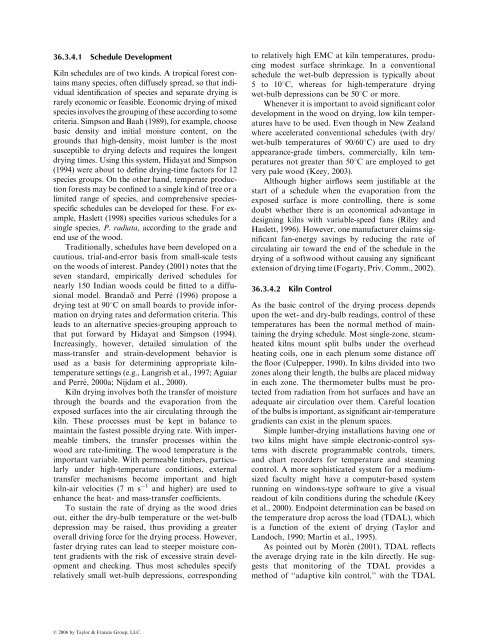36 Drying of Wood
36 Drying of Wood
36 Drying of Wood
- No tags were found...
Create successful ePaper yourself
Turn your PDF publications into a flip-book with our unique Google optimized e-Paper software.
<strong>36</strong>.3.4.1 Schedule DevelopmentKiln schedules are <strong>of</strong> two kinds. A tropical forest containsmany species, <strong>of</strong>ten diffusely spread, so that individualidentification <strong>of</strong> species and separate drying israrely economic or feasible. Economic drying <strong>of</strong> mixedspecies involves the grouping <strong>of</strong> these according to somecriteria. Simpson and Baah (1989), for example, choosebasic density and initial moisture content, on thegrounds that high-density, moist lumber is the mostsusceptible to drying defects and requires the longestdrying times. Using this system, Hidayat and Simpson(1994) were about to define drying-time factors for 12species groups. On the other hand, temperate productionforests may be confined to a single kind <strong>of</strong> tree or alimited range <strong>of</strong> species, and comprehensive speciesspecificschedules can be developed for these. For example,Haslett (1998) specifies various schedules for asingle species, P. radiata, according to the grade andend use <strong>of</strong> the wood.Traditionally, schedules have been developed on acautious, trial-and-error basis from small-scale testson the woods <strong>of</strong> interest. Pandey (2001) notes that theseven standard, empirically derived schedules fornearly 150 Indian woods could be fitted to a diffusionalmodel. Brandaõ and Perré (1996) propose adrying test at 908C on small boards to provide informationon drying rates and deformation criteria. Thisleads to an alternative species-grouping approach tothat put forward by Hidayat and Simpson (1994).Increasingly, however, detailed simulation <strong>of</strong> themass-transfer and strain-development behavior isused as a basis for determining appropriate kilntemperaturesettings (e.g., Langrish et al., 1997; Aguiarand Perré, 2000a; Nijdam et al., 2000).Kiln drying involves both the transfer <strong>of</strong> moisturethrough the boards and the evaporation from theexposed surfaces into the air circulating through thekiln. These processes must be kept in balance tomaintain the fastest possible drying rate. With impermeabletimbers, the transfer processes within thewood are rate-limiting. The wood temperature is theimportant variable. With permeable timbers, particularlyunder high-temperature conditions, externaltransfer mechanisms become important and highkiln-air velocities (7 m s 1 and higher) are used toenhance the heat- and mass-transfer coefficients.To sustain the rate <strong>of</strong> drying as the wood driesout, either the dry-bulb temperature or the wet-bulbdepression may be raised, thus providing a greateroverall driving force for the drying process. However,faster drying rates can lead to steeper moisture contentgradients with the risk <strong>of</strong> excessive strain developmentand checking. Thus most schedules specifyrelatively small wet-bulb depressions, correspondingto relatively high EMC at kiln temperatures, producingmodest surface shrinkage. In a conventionalschedule the wet-bulb depression is typically about5 to 108C, whereas for high-temperature dryingwet-bulb depressions can be 508C or more.Whenever it is important to avoid significant colordevelopment in the wood on drying, low kiln temperatureshave to be used. Even though in New Zealandwhere accelerated conventional schedules (with dry/wet-bulb temperatures <strong>of</strong> 90/608C) are used to dryappearance-grade timbers, commercially, kiln temperaturesnot greater than 508C are employed to getvery pale wood (Keey, 2003).Although higher airflows seem justifiable at thestart <strong>of</strong> a schedule when the evaporation from theexposed surface is more controlling, there is somedoubt whether there is an economical advantage indesigning kilns with variable-speed fans (Riley andHaslett, 1996). However, one manufacturer claims significantfan-energy savings by reducing the rate <strong>of</strong>circulating air toward the end <strong>of</strong> the schedule in thedrying <strong>of</strong> a s<strong>of</strong>twood without causing any significantextension <strong>of</strong> drying time (Fogarty, Priv. Comm., 2002).<strong>36</strong>.3.4.2 Kiln ControlAs the basic control <strong>of</strong> the drying process dependsupon the wet- and dry-bulb readings, control <strong>of</strong> thesetemperatures has been the normal method <strong>of</strong> maintainingthe drying schedule. Most single-zone, steamheatedkilns mount split bulbs under the overheadheating coils, one in each plenum some distance <strong>of</strong>fthe floor (Culpepper, 1990). In kilns divided into twozones along their length, the bulbs are placed midwayin each zone. The thermometer bulbs must be protectedfrom radiation from hot surfaces and have anadequate air circulation over them. Careful location<strong>of</strong> the bulbs is important, as significant air-temperaturegradients can exist in the plenum spaces.Simple lumber-drying installations having one ortwo kilns might have simple electronic-control systemswith discrete programmable controls, timers,and chart recorders for temperature and steamingcontrol. A more sophisticated system for a mediumsizedfaculty might have a computer-based systemrunning on windows-type s<strong>of</strong>tware to give a visualreadout <strong>of</strong> kiln conditions during the schedule (Keeyet al., 2000). Endpoint determination can be based onthe temperature drop across the load (TDAL), whichis a function <strong>of</strong> the extent <strong>of</strong> drying (Taylor andLandoch, 1990; Martin et al., 1995).As pointed out by Morén (2001), TDAL reflectsthe average drying rate in the kiln directly. He suggeststhat monitoring <strong>of</strong> the TDAL provides amethod <strong>of</strong> ‘‘adaptive kiln control,’’ with the TDALß 2006 by Taylor & Francis Group, LLC.
















